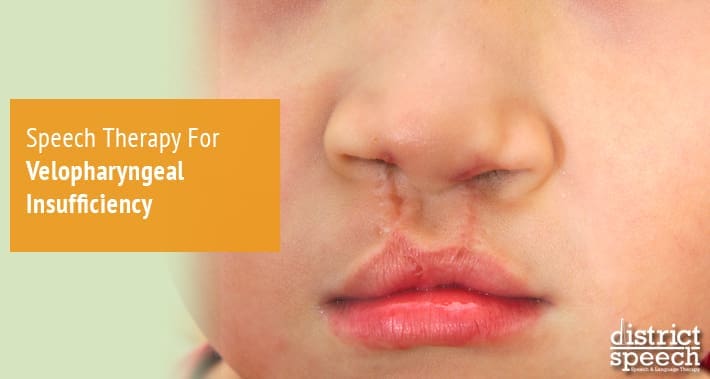
If you run your tongue along the roof of your mouth towards your throat, you’ll notice the texture changes from hard and bony to soft.
Where the roof of your mouth becomes soft is what’s known as your soft palate.
It’s actually a muscle that moves up and down as you speak and swallow.
Velopharyngeal insufficiency is when your soft palate is unable to close tightly against the back of your throat, most commonly caused by cleft lip and cleft palate.
It’s what’s known as a resonance disorder.
To treat velopharyngeal insufficiency, you’ll often need surgery to correct it, because of the physical gap between the back of the throat and soft palate.
Afterwards though, it’s a good idea to work with a speech therapist.
Now, let’s find out more about velopharyngeal insufficiency and how a speech therapist can help.
What Is Velopharyngeal Insufficiency?
When you pronounce consonants like the letters ‘p’, ‘w’, and ‘x’, your soft palate closes against the back of your throat.
If you have velopharyngeal insufficiency, your soft palate can’t close properly the way it needs to.
When you speak, it causes air to escape out of your nose.
Often you’ll notice a nasal quality to your speech.
It can also cause speech that is difficult to understand.
This causes what’s called a resonance disorder when you speak.
If you have a serious case of velopharyngeal insufficiency, you may regurgitate food or liquids out of your nose when you eat.
What Causes Velopharyngeal Insufficiency?
Your child is most likely to experience velopharyngeal insufficiency if they have a cleft palate or shortened palate.
RELATED: Frequently Asked Questions About Cleft Lip And Cleft Palate
In fact, around 20% of children who have their cleft palates repaired will experience velopharyngeal insufficiency.
However, this is not the only cause of velopharyngeal insufficiency.
Sometimes, having an adenoidectomy can result in velopharyngeal insufficiency.
An adenoidectomy is a procedure to remove your adenoid glands, located in the back of your throat just behind your uvula.
It usually happens because of chronic infection.
Sometimes, this can create more space between your soft palate and the back of your throat.
This prevents your soft palate from closing, which can cause velopharyngeal insufficiency.
This is often temporary and typically improves after a few weeks, though.
Velopharyngeal insufficiency is also linked to certain genetic disorders like Down syndrome.
If your child has cerebral palsy, they may also experience velopharyngeal insufficiency.
This is because cerebral palsy is associated with muscle weakness and difficulty with both gross motor skills and fine motor skills.
The muscle weakness your child experiences due to cerebral palsy can cause difficulty when it comes to the muscles required to press their soft palate against their throat.
Sometimes, the cause of velopharyngeal insufficiency remains unknown.
What Are The Symptoms Of Velopharyngeal Insufficiency?
There are many different symptoms of velopharyngeal insufficiency.
Your child may only experience some symptoms and symptoms can differ from child to child.
When it comes to speech, velopharyngeal insufficiency most often causes difficulty with resonance and articulation.
A very common symptom is hypernasality in your child’s speech.
This happens because there is too much sound resonating in the nasal cavity.
You might notice your child has trouble forming certain words.
This will likely be especially true when it comes to letters like ‘p’, ‘b’, ‘g’, ‘t’, and ‘d’.
You may also notice they have difficulty with some vowels.
In some cases, you can even hear the air escaping from your child’s nose as they speak.
Your child might have other speech quirks due to their velopharyngeal insufficiency.
You may notice they take awkward stops while they speak in order to take breaths.
They may also sometimes have muffled sounding speech, even though there is nothing blocking their mouth.
In extreme cases, you might also notice food or drink escape from your child’s nose while they are eating.
How Is Velopharyngeal Insufficiency Diagnosed?
A speech pathologist can determine if your child’s speech deficit is caused by velopharyngeal insufficiency or something else.

How Does A Speech Therapist Treat Velopharyngeal Insufficiency?
If your child does have velopharyngeal insufficiency, the first step in correcting it is surgery.
About six weeks post surgery after surgery, it’s a good idea to speak with a speech therapist.
Children with velopharyngeal insufficiency often produce sounds incorrectly post surgery.
If you or your child is experiencing that, speech therapy can help.
There are a number of different ways a speech therapist can do this.
First, your child’s speech therapist will help them unlearn the habits they used to compensate for their velopharyngeal insufficiency.
This is why it’s important to start speech therapy early.
In fact, the idea that you ought to just wait and see if your child’s speech improves on its own is a common speech therapy myth.
It’s never too early to begin speech therapy, and early intervention can help reduce the bad habits your child will pick up.
Primarily, it’s by focusing on correcting any articulation errors and eliminating velopharyngeal mislearned patterns.
This will help reduce the amount of hypernasality your child has in their speech.
Often, a speech therapist will start with what are known as voiceless sounds.
These are letters like ‘w’, ‘h’, ‘p’, and ‘t’.
Once your child has mastered these, they will move on to voiced sounds.
Your child may have developed something called velopharyngeal mislearning due to their velopharyngeal insufficiency.
This occurs when your child learns to pronounce sounds like ‘s’ or ‘pr’ through their nose instead of their mouth.
This is something that can contribute to the nasal quality of their voice.
Correcting this can improve their resonance and eliminate any air escaping through their nose as they speak.
Some strategies your speech therapist might use for this include:
- Tactile feedback (feeling the nose during oral and nasal speech)
- Visual feedback
- Auditory feedback
- Increased articulatory effort: increasing their loudness level
- Increase general awareness of oral and nasal airflow
- Description exercises
Book Your Appointment With District Speech Today
As you can see, speech therapy is a great resource to help your child recover from velopharyngeal insufficiency.
Although surgery is typically required, the valuable skill set of a speech therapist is still required in order to correct your child’s speech patterns going forward.
As always, the earlier your child is able to start speech therapy, the greater the chances for success.
This is because there has been less of an opportunity for their bad habits to get ingrained.
It is important to address velopharyngeal insufficiency quickly in order to set your child up for success later in life.
Book your appointment today with District Speech to get started and schedule an evaluation.
We look forward to working with you.
Book your appointment with District Speech today.
1300 I St NW, Suite 400 E,
Washington, DC 20005
- https://g.page/districtspeech
District Speech and Language Therapy specializes in speech therapy, physical therapy, and occupational therapy solutions, for both children and adults, in the Washington D.C and the Arlington Virginia areas.